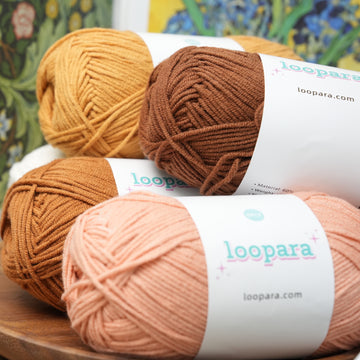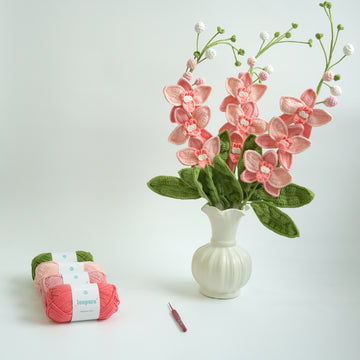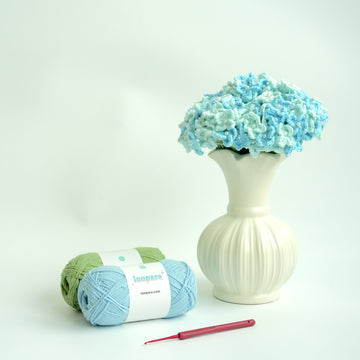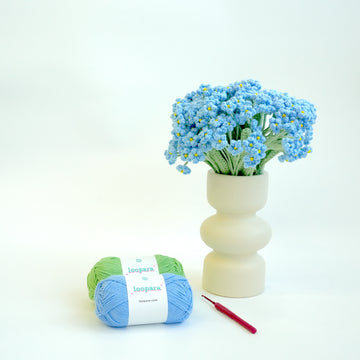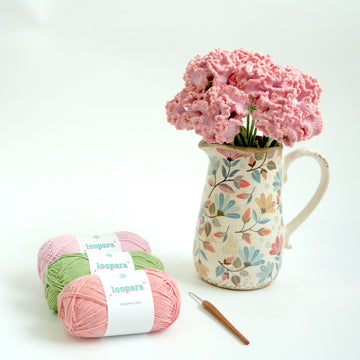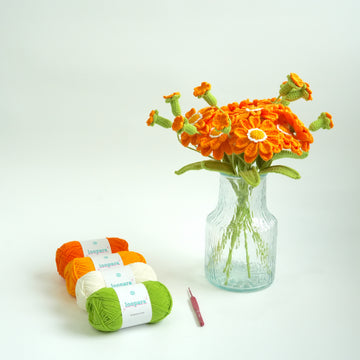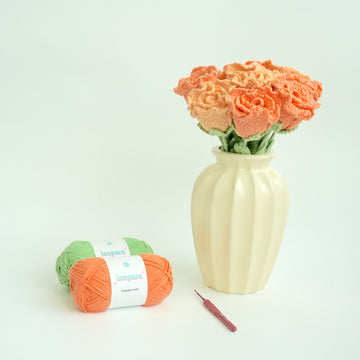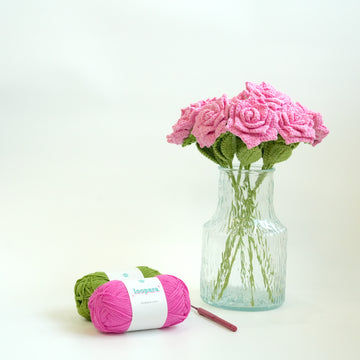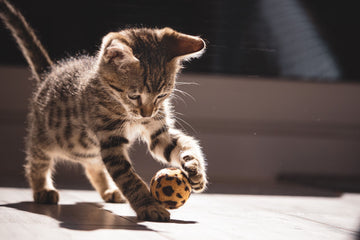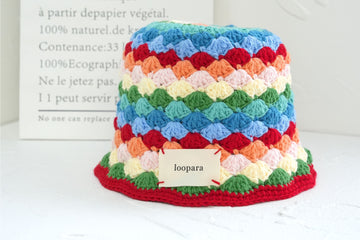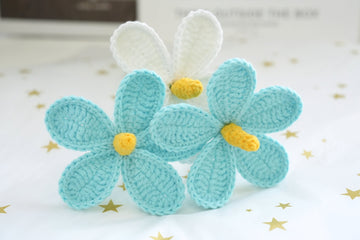There are all kinds of interesting yarn types out there. We’re going to take a look at one in particular, and answer the question of “What is milk cotton yarn?”
We’ll explore the difference between the milk cotton yarns of the past and those being made today. And we’ll learn more about its production and properties.
Ready? Then let’s get started!
Milk cotton yarn in the 1930s
Milk cotton yarn was first produced in Italy in the 1930s using casein, a protein in milk. You may also hear it referred to as casein fiber or milk fiber.
It was invented by an Italian named Antonio Ferretti, and was designed to make Italy more self-sufficient. It was marketed under the trade name Lanital.
But while milk cotton yarn might sound like a natural product, the 1930s version was a long way from that.
Turning the casein fibers in milk into a yarn required multiple processes. And some of these involved toxic chemicals.
A major part of production involved attaching casein to acrylonitrile. This is the same substance which is still used today to make acrylic yarn. And it comes from petrochemicals, so it’s not good news for the planet.
Today, we also know that acrylic leaches microplastics into water systems when it’s washed. So it’s a fair bet that milk cotton yarn made with acrylonitrile does the same thing.
Milk cotton yarn also has to be immersed in an alkaline substance, then sulfuric acid, during production. What’s more, the finishing process involves aluminum salts and formaldehyde. Formaldehyde is highly toxic for humans and the planet.
All these requirements meant that milk cotton yarn was quite expensive to produce. As a result, it fell out of favor by the 1940s, replaced by cheaper synthetic fibers like acrylic.
Today’s milk cotton yarn

Today, milk cotton yarn isn’t easy to find in most parts of the world. But it’s still being made and is part of the group of textiles known as Azlon. These are synthetic fibers that use proteins from natural sources like milk, soy, corn and peanuts.
More recently, some modern manufacturers have picked up on the idea of using milk to make yarn. And they’ve been trying to do so in ways that are less damaging to the environment.
One German start-up, QMilk, claims to have found a sustainable way to produce milk cotton yarn.
They say the process starts with sour milk from dairies. This is milk that would otherwise have been thrown away. But the sourness is essential to the yarn-making process – it’s necessary to separate out the casein.
QMilk’s founder, Anke Domaske, argues that creating the yarn is a way of reducing food waste. In Germany alone, around 2 million tonnes of cow’s milk are thrown away every year.
The milk protein is sourced from dairies in the form of powder. It’s then mixed with water to form a sort of dough, which can be stretched into threads. Domaske describes the yarn as being like a type of noodle.
There’s clearly more to the process than this, so it’s not yet possible to assess the full environmental impact of QMilk yarn. But according to the company, casein powder and two liters of water heated to 80 degrees Celsius is all it takes to produce 1 kilogram of yarn.
QMilk also claim that they use only renewable energy in their production processes. And they aim to have zero waste throughout their supply and production chain.
Properties of milk cotton yarn

So what does milk cotton yarn look and feel like?
Well, one of its standout properties is that, like wool, it’s very good at wicking away moisture. It’s reasonably breathable too, although it’s not as warm as wool.
It’s fairly stretchy too. It’s good at resisting pilling – the unattractive bobbles that can form on the surface of fabrics. And milk cotton yarn made with casein and polypropylene has been shown to have antibacterial properties.
All that means that milk cotton yarn is often used for clothing that’s worn close to the skin. But that does present risks for people who have milk allergies.
How easy it is to launder depends on what type of milk cotton yarn it is. QMilk, made with pure casein, can apparently be washed at high temperatures. Forms blended with acrylonitrile might do better on a cooler wash. And they should certainly be kept away from tumble driers.
Milk cotton yarn and allergies
A number of online articles state that milk cotton yarn is hypoallergenic. This isn’t the case.
Milk contains many different proteins, minerals and other substances. But amongst them are more than 20 proteins that can be allergenic. These include casein.
Someone with a milk allergy could be allergic to one of the other proteins in milk – whey, for example, is more allergenic than casein. But if they’re allergic to casein, it’s possible that milk cotton yarn could have serious effects.
In most cases, casein allergies are experienced by young children who grow out of them as they get older. But that’s not the case for everyone.
How someone with a casein allergy will react to milk cotton yarn will depend on how severe their allergy is. It’s also likely to vary according to how the yarn was processed. If the protein remains whole, it’s more likely to trigger an allergic reaction.
Symptoms of casein allergy
Allergic reactions from casein vary from mild to severe. They include:
- Swollen tongue, throat, lips or mouth
- Skin rashes, hives, or red and itchy skin
- Itchy eyes and nose, runny or congested nose, coughing, sneezing and wheezing.
The reaction happens because the body wrongly identifies casein as a threat. This triggers the body’s defences, sending out chemicals called histamines to eject the invader.
In the most serious cases, casein can trigger anaphylaxis, a life-threatening condition. The symptoms of this include swelling inside the mouth, difficulty breathing, chest pain, and hives.
This normally happens very quicky after someone has consumed a milk product. But anyone with a severe casein allergy would be sensible to stay away from milk cotton yarn too.
Alternatives to milk cotton yarn

Milk cotton yarn is often used for fabrics where softness is key. Here are some other options to consider.
Wool
Milk cotton yarn was originally produced as an alternative to wool. Wool is light, warm, and natural. It’s great at wicking away moisture too.
But it needs a little more care. It can be put into a washing machine, but only on a cool temperature and with specialist wool wash. And it shouldn’t be put into a tumble drier or it will shrink and felt.
Some people have allergies to the lanolin that’s in wool too. And wool is more expensive than synthetic fibers.
Bamboo
Sustainably produced bamboo yarn is a great product that’s growing in popularity. It’s soft, light and stretchy. And it’s breathable too.
Bamboo yarn can be an ethical choice for the planet too. It grows much more quickly and requires less water than cotton. But watch out for products that have been subjected to chemical-intensive manufacturing processes.
Look for yarns that have been accredited by GOTS, the Global Organic Textiles Standard.
Cotton
Cotton is widely available and hypoallergenic. It’s a good choice for summer clothing, and washes and dyes well.
It’s also easy to crochet with. Cotton yarns generally have well defined stitches and drape well. And they’re robust enough to be put into the washing machine and tumble drier.
There’s lots of versatility in cotton yarns too. You’ll be able to choose from multiple yarn weights, shades and twists.
Cotton doesn’t retain heat well, though, so it’s not the best choice for winter clothing or snuggly blankets. It’s pricier than synthetic yarns. And it requires lots of water to grow, plus a climate where water is typically scarce.
You can minimise the environmental impact of your cotton yarn by choosing one that’s been produced without pesticides. Look for the GOTS label which certifies organic yarn.
Acrylic
If you’re looking for a soft, inexpensive yarn, acrylic is an obvious choice. It comes in pretty much all yarn weights and colors. And the finished item will cope with being put into a washing machine, even at higher temperatures.
Keep it away from the tumble drier, though. The hotter temperatures mean that the fibers can shrink or melt (i.e. become floppy and shiny).
Note too that acrylic fibers are produced from fossil fuels, so they’re not sustainable. And they will leach microplastics – substances that are hazardous to human health – when they’re washed.
Also Read: Cotton vs. Acrylic Yarn: Which Is Better?
Summary: What is milk cotton yarn?
Milk cotton yarn is made from a protein called casein in milk.
Traditional milk cotton yarns combine this with other chemicals to produce a synthetic yarn. These processes use toxic chemicals, but new producers claim to have achieved great results without them. So it’s possible more sustainable milk cotton yarns will be available in the future.
Milk cotton yarn is typically soft, good at wicking away moisture, and fairly warm. But it may trigger an allergic reaction in people with a casein allergy.


